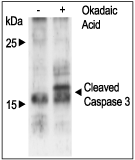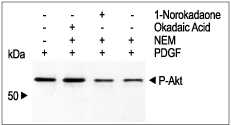Overview
Cat #:
O-800
Alternative Name Halochondrine A
Lyophilized Powder yes
Origin Halichondria okadai (marine sponge).
Source Natural
MW: 822.04
Purity: >98%
Effective concentration 1 nM-1 µM.
Chemical name (2R)-3-[(2S,6R,8S,11R)-2-[(E,2R)-4- [(2S,2'R,4R,4aS,6R,8aR)-4-hydroxy-2-[(1S,3S)-1-hydroxy-3-[(2S,3R,6S)- 3-methyl-1,7-dioxaspiro[5.5]undecan-2-yl]butyl]-3- methylidenespiro[4a,7,8,8a-tetrahydro-4H-pyrano[3,2-b]pyran-6,5'- oxolane]-2'-yl]but-3-en-2-yl]-11-hydroxy-4-methyl-1,7- dioxaspiro[5.5]undec-4-en-8-yl]-2-hydroxy-2-methylpropanoic acid.
Molecular formula C44H71O13N.
CAS No.: 155716-06-6
Activity Okadaic Acid is a potent inhibitor of PP1 and PP2A1. At higher concentrations, it also promotes apoptosis2.
References-Activity
- Bialojan, C. and Takai, A. (1988) Biochem. J. 256, 283.
- Meikrantz, W. et al. (1994) Proc. Natl. Acad. Sci. U. S. A. 91, 3754.
Shipping and storage Shipped at room temperature. Product as supplied can be stored intact at room temperature for several weeks. For longer periods, it should be stored at -20°C.
Solubility DMSO, ethanol, acetone, or methanol. Centrifuge all product preparations before use (10000 x g 5 min).
Storage of solutions Up to one week at 4°C or three months at -20°C.
Protect from light.
Protect from light.
Our bioassay
 Alomone Labs Okadaic Acid induces apoptosis in Jurkat cells.Cells were grown to 70% confluency followed by the addition of 1µM Okadaic Acid (ammonium salt) (#O-800) (or Okadaic Acid (sodium salt) (#O-900)) or vehicle for 6 h. At the end of the incubation, cell proteins were resolved by SDS-PAGE and probed with anti-Caspase 3 antibody.
Alomone Labs Okadaic Acid induces apoptosis in Jurkat cells.Cells were grown to 70% confluency followed by the addition of 1µM Okadaic Acid (ammonium salt) (#O-800) (or Okadaic Acid (sodium salt) (#O-900)) or vehicle for 6 h. At the end of the incubation, cell proteins were resolved by SDS-PAGE and probed with anti-Caspase 3 antibody. Alomone Labs Okadaic Acid inhibits PP2A in 3T3-L1 cells.Cells were grown to 70% confluence and serum starved for 18 h. For in vivo phosphatase activity, the growth medium was replaced with HENK’s and the cells were preincubated in the presence or absence of 100 nM Okadaic Acid (ammonium salt) (#O-800), (or Okadaic Acid (sodium salt) (#O-900)) and 100 nM 1-Norokadaone (#N-750) followed by a 20 min incubation with or without 20 µM NEM. The cells were then stimulated with 5 ng/ml PDGF for 30 min. At the end of the incubation, cell proteins were resolved by SDS-PAGE and probed with anti-phospho-Akt antibodies.
Alomone Labs Okadaic Acid inhibits PP2A in 3T3-L1 cells.Cells were grown to 70% confluence and serum starved for 18 h. For in vivo phosphatase activity, the growth medium was replaced with HENK’s and the cells were preincubated in the presence or absence of 100 nM Okadaic Acid (ammonium salt) (#O-800), (or Okadaic Acid (sodium salt) (#O-900)) and 100 nM 1-Norokadaone (#N-750) followed by a 20 min incubation with or without 20 µM NEM. The cells were then stimulated with 5 ng/ml PDGF for 30 min. At the end of the incubation, cell proteins were resolved by SDS-PAGE and probed with anti-phospho-Akt antibodies.
References - Scientific background
- Murakumi, Y et al. (1982) Bull. Jpn. Soc. Sci. Fish. 48, 69.
- Suganuma, M. et al. (1988) Proc. Natl. Acad. Sci. U. S. A. 85, 1768.
- Cohen, P. et al. (1990) Trends Biochem Sci. 15, 1837.
- Haystead, T.A. et al. (1989) Nature 337, 78081.
- Higuchi, M. and Aggarwal, B.B. (1993) J. Biol. Chem. 268, 5624.
- Van Dolah, F.M. and Ramsdell, J.S. (1992) J. Cell Physiol. 152, 190.
Scientific background
Okadaic acid is a polyether compound isolated from the black sponge Halichondria okadai. It was previously demonstrated as a non-TPA-type tumor promoter and then as a cell-permeable, potent and specific inhibitor of serine/threonine protein phosphatases 1 and 2A. In higher concentrations Okadaic acid induced apoptosis (IC50 = 0.5 µM).1-4
Okadaic acid down-regulates the TNF receptor, induces the release of Ca2+ from intracellular stores in ECV304 endothelial cells and inhibits GH4 cell proliferation in a concentration-dependent manner (IC50 = 5 nM).5,6
Lyophilized Powder
Okadaic Acid (ammonium salt) (#O-800) is a highly pure, natural, and biologically active compound.
For research purposes only, not for human use
Last Update: 08/01/2025
Applications
Citations
Citations

